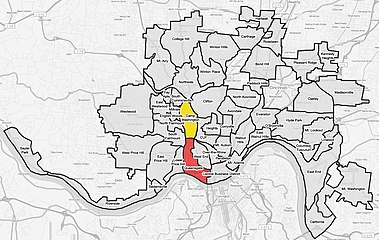Queensgate Yard
| Queensgate Yard | |
|---|---|
|
The marshalling yard as seen from the west, the former Cincinnati Union Terminal at the top right |
|
| Data | |
| Operating point type | Marshalling yard |
| Design | Through station |
| opening | 1981 |
| location | |
| Place / district | Cincinnati |
| State | Ohio |
| Country | United States |
| Coordinates | 39 ° 7 '57 " N , 84 ° 32' 31" W |
| List of train stations in the United States | |
The Queensgate Yard is a freight and marshalling yard of CSX Transportation in the south of Cincinnati , Ohio . It is located in the lower valley of Mill Creek , which extends north to south across the neighborhoods of Camp Washington and Queensgate. The river runs on the west side of the eight kilometer long station and then flows into the Ohio River . The station was built in the 1970s by the Chessie System holding company , which has comprised the Chesapeake and Ohio Railway , the Baltimore and Ohio Railroad and the Western Maryland Railway since 1973 and was incorporated into CSX Transportation in 1987 .
history
At the end of the 19th century, Cincinnati became the third largest transshipment point for rail freight in the USA after Chicago and St. Louis . At that time, the city was still mainly the end point of several railroad lines, but with the expansion of the railroad network in North America and the construction of railway bridges over the Ohio, including three in Cincinnati by 1888, more and more freight cars were shunted in the city after the turn of the century than be - or discharged. The up to 15 railway companies maintained a large number of passenger and freight stations in the city , which were only partially connected to each other. In the 1920s, seven of the big companies decided to build a joint passenger station in Queensgate, which was completed by 1933 and had a daily capacity of over 200 trains. With the onset of the expansion of the road network and the emergence of motorized individual traffic, the Cincinnati Union Terminal has increasingly lost its importance since the 1950s and was shut down in the early 1970s, the terminal hall has been preserved as the Cincinnati Museum Center at Union Terminal .
With the construction of the Cincinnati Union Terminal , a massive expansion of the rail network in and around the city was necessary, which also led to an improvement in freight traffic. The average shunting time of freight cars in the city was 24 hours in the 1960s and the Chesapeake and Ohio Railway and the Baltimore and Ohio Railroad planned to merge their five marshalling and freight yards in the lower Mill Creek valley with the construction of the Queensgate Yard , above the tracks of the Cincinnati Union Terminal . The holding company Chessie System , founded in 1973, implemented the plans and the marshalling yard went into operation on July 23, 1981, reducing the shunting time to 12 hours. In the period that followed, freight traffic also shifted from nearby train stations to Queensgate, which were then closed. The Southern Railway integrated the former railway tracks of the passenger station in the south into its neighboring Gest Street Yard marshalling yard , which is now operated by the Norfolk Southern Railway (NS) and is partially enclosed by the foothills of the Queensgate Yard . Until 1987, the holding company Chessie System went together with the Seaboard Coast Line Railroad in the CSX Transportation , which is now the operator of the station.
description
The eight kilometer long flat station has eight entry tracks in the south, 50 direction tracks in the middle direction harp and a follow-up and exit group of eight or six tracks in the north. In addition, an auxiliary group of 19 tracks is connected to the north of the direction harp. There is also a container terminal with five tracks for intermodal freight traffic in the eastern part of the station . The facilities also include several tracks from railway depots , with maintenance halls for the freight cars (4 tracks) and diesel locomotives (3 tracks), which are located at the level of the direction harp or next to the signal box . The marshalling yard is designed for a capacity of 3,200 freight wagons; the usual throughput in 2013 was around 2,000 wagons a day. With a total volume of almost 500,000 wagons and containers handled annually, Queensgate Yard is one of the ten most important marshalling and freight yards in the CSX network.
From the south, the marshalling yards are accessed via the Cincinnati Southern Bridge (NS) and the neighboring C&O Railroad Bridge (CSX), which cross the Ohio below the stations.
Marshalling yards behind what is now the Cincinnati Museum Center at Union Terminal , looking east
See also
Web links
- CSX Queensgate Yard. Railroads of Cincinnati, CincyRails.com
- Chessie System Queensgate Yard Cincinnati, Ohio. RailsandTrails.com
literature
- Michael Rhodes: North American Railyards. Voyageur Press, Minneapolis 2014, ISBN 978-0-76034-609-9 , pp. 164-166.
- Dave Ori: Chessie System. Voyageur Press, St. Paul 2006, ISBN 978-0-7603-2339-7 , pp. 114-119.
Individual evidence
- ^ A b Railroad Improvement and Safety Plan. City of Cincinnati, Department of Transportation and Engineering, 2013, pp. 6-10.
- ^ About Union Terminal. Cincinnati Museum Center, accessed March 23, 2019.
- ↑ a b Dave Ori: Chessie System. Voyageur Press, St. Paul 2006, ISBN 978-0-7603-2339-7 , pp. 114-119.
- ↑ Paul A. Tenkotte, James C. Claypool: The Encyclopedia of Northern Kentucky. University Press of Kentucky, Lexington 2009, ISBN 978-0-8131-2565-7 , pp. 745 f.
- ↑ Michael Rhodes: North American Railyards. Voyageur Press, Minneapolis 2014, ISBN 978-0-76034-609-9 , pp. 164-166.
- ↑ 2016 Anual Report. CSX Corporation, 2017, p. 12, accessed March 23, 2019.






